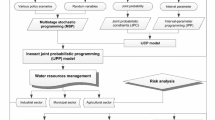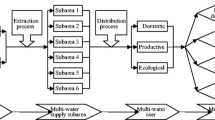Abstract
In this study, an interval parameter multistage joint-probability programming (IMJP) approach has been developed to deal with water resources allocation under uncertainty. The IMJP can be used not only to deal with uncertainties in terms of joint-probability and intervals, but also to examine the risk of violating joint probabilistic constraints in the context of multistage. The proposed model can handle the economic expenditure caused by regional water shortage and flood control. The model can also reflect the related dynamic changes in the multi-stage cases and the system safety under uncertainty. The developed method is applied to a case study of water resources allocation in Shandong, China, under multistage, multi-reservoir and multi-industry. The violating reservoir constraints are addressed in terms of joint-probability. Different risk levels of constraint lead to different planning. The obtained results can help water resources managers to identify desired system designs under various economic, environment and system reliability scenarios.







Similar content being viewed by others
Abbreviations
- \( f^{ \pm } \) :
-
Objective function, total benefits of the system
- \( R_{{tk_{1} }}^{ \pm } \) :
-
Auxiliary variable, distributary volume from reservoir 1 (Tianzhuang reservoir) under the scenario of K1 in period t
- \( R_{{tk_{1} k_{2} }}^{ \pm } \) :
-
Auxiliary variable, distributary volume from reservoir 2 (Bashan reservoir) in period t under the situation when scenario K1 and K2 are in joint probability form
- \( S_{{tk_{1} }}^{ \pm } \) :
-
Auxiliary variable, storage water volume of reservoir 1 (Tianzhuang reservoir) under the scenario of K1 in period t
- \( S_{{tk_{1} k_{2} }}^{ \pm } \) :
-
Auxiliary variable, storage water volume of reservoir 2 (Bashan reservoir) in period t under the situation when scenario K1 and K2 are in joint probability form
- \( X_{t}^{ \pm } \) :
-
Decision variable, the promised water supply to county from the reservoir
- \( X_{it}^{ \pm } \) :
-
Decision variable, the promised water supply to each industry from the reservoir
- \( SH_{{tk_{1} k_{2} }}^{ \pm } \) :
-
Decision variable, the gap of water shortage between the actual water supply and the promised water supply to three industries from the reservoir in period t in the situation when scenario K1 and K2 are in joint probability form
- \( SH_{{itk_{1} k_{2} }}^{ \pm } \) :
-
Decision variable, the gap of water shortage between the actual water supply and the promised water supply to each industry from the reservoir in period t in the situation when scenario K1 and K2 are in joint probability form
- \( SU_{{tk_{1} k_{2} }}^{ \pm } \) :
-
Decision variable, distributary volume from reservoir in period t under the situation when scenario K1 and K2 are in joint probability form
- \( C_{CL} \) :
-
Canal loss coefficient
- \( C_{SL} \) :
-
Seepage loss coefficient
- \( C_{EL} \) :
-
Evaporation loss coefficient
- \( De_{t}^{\hbox{min} } \) :
-
Minimum water demand of three industries in period t
- \( De_{t}^{\hbox{max} } \) :
-
Maximum water demand of three industries in period t
- \( De_{it}^{\hbox{min} } \) :
-
Minimum water demand of each industry in period t
- \( De_{it}^{\hbox{max} } \) :
-
Maximum water demand of each industry in period t
- \( De_{et}^{\pm} \) :
-
Ecological water requirement of county in period t
- \( De_{lt}^{\pm} \) :
-
Domestic water requirement of county in period t
- \( DR \) :
-
Dead storage for reservoir
- \( NB_{it} \) :
-
Net benefit per unit of water allocated to each industry in period t
- \( PE_{t}^{ \pm } \) :
-
Penalty per unit of shortage water not delivered to three industries
- \( PE_{it}^{ \pm } \) :
-
Penalty per unit of shortage water not delivered to each industry
- \( P_{{tk_{1} }} \) :
-
Probability of the occurrence of scenario k 1 in period t
- \( P_{{tk_{2} }} \) :
-
Probability of the occurrence of scenario k 2 in period t
- \( Q \) :
-
Joint probability of exceeding constraints of the reservoir-storage capacities
- \( q1 \) :
-
Probability of exceeding constraint of the storage capacity of reservoir 1
- \( q2 \) :
-
Probability of exceeding constraint of the storage capacity of reservoir 2
- \( \tilde{Q}_{{tk_{1} }}^{ \pm } \) :
-
The flow of stream 1 in period t under the scenario \( k_{1} \)
- \( \tilde{Q}_{{tk_{2} }}^{ \pm } \) :
-
The flow of stream 1 in period t under the scenario \( k_{2} \)
- \( TR^{\pm} \) :
-
Total reservoir capacity
- \( UR \) :
-
Useful reservoir capacity
- \( VC_{t}^{ \pm } \) :
-
The float charge of diversion in the period t
- \( i \) :
-
Industry (primary industry, secondary industry, tertiary industry)
References
Anderson ML, Mierzwa MD, Kavvas ML (2000) Probabilistic seasonal forecasts of droughts with a simplified coupled hydrologic–atmospheric model for water resources planning. Stoch Environ Res Risk Assess 14(4):263–274
Barros MTL, Yang S, Lopes JEG (2003) Optimization of large-scale hydropower system operations. J Water Resour Plan Manag 129(3):178–188
Cancelliere A, Giuliano G, Ancarani A, Rossi G (2002) A neural networks approach for deriving irrigation reservoir operating rules. Water Resour Manag 16(1):71–88
Chan SO, Bras RL (1979) Urban storm water management: distribution of flood volumes. Water Resour Res 15(2):371–382
Charnes A, Cooper WW (1983) Response to decision problems under risk and chance constrained programming: dilemmas in the transitions. Manag Sci 29:750–753
Charnes JM, Shenoy PP (2004) Multistage Monte Carlo method for solving influence diagrams using local computation. Manag Sci 50:405–418
Charnes A, Cooper WW, Kirby P (1972) Chance constrained programming: an extension of statistical method. In: Rustagi S (ed) Optimizing methods in statistics. Academic Press, New York, pp 391–402
Ellis JH (1991) Stochastic programs for identifying critical structural collapse mechanisms. Appl Math Model 15:367–379
Fan YR, Huang GH, Guo P, Yang AL (2012) Inexact two-stage stochastic partial programming: application to water resources management under uncertainty. Stoch Environ Res Risk Assess 26:281–293
Guo P, Huang GH (2009) Two-stage fuzzy chance-constrained programming: application to water resources management under dual uncertainties. Stoch Environ Res Risk Asses 23(3):349–359
Guo P, Huang GH, He L, Zhu H (2009) Interval-parameter two-stage stochastic semi-infinite programming: application to water resources management under uncertainty. Water Resour Manag 23(8):1001–1023
Guo P, Huang GH, Li YP (2010) Inexact fuzzy-stochastic programming for water resources management under multiple uncertainties. Environ Model Assess 15:111–124. doi:10.1007/s10666-009-9194-6
Hausman WH, Lee HL, Zhang AX (1998) Joint demand fulfillment probability in a multi-item inventory system with independent order-up-to policies. Eur J Oper Res 109(3):646–659
Heidari M, Te Chow V, Kokotović PV, Meredith DD (1971) Discrete differential dynamic programing approach to water resources systems optimization. Water Resour Res 7(2):273–282
Huang GH (1996) IPWM: an interval parameter water quality management model. Eng Optim 26:79–103
Huang GH (1998) A hybrid inexact-stochastic water management model. Eur J Oper Res 107:137–158
Huang G, Baetz BW, Patry GG (1995) Grey integer programming: an application to waste management planning under uncertainty. Eur J Oper Res 83(3):594–620
Infanger G (1992) Monte Carlo (importance) sampling within a benders decomposition algorithm for stochastic linear programs. Ann Oper Res 39:69–81
Li YP, Huang GH (2008) Interval-parameter two-stage stochastic nonlinear programming for water resources management under uncertainty. Water Resour Manag 22(6):681–698
Li YP, Huang GH, Nie SL (2006) An interval-parameter multi-stage stochastic programming model for water resources management under uncertainty. Adv Water Resour 29:776–789. doi:10.1016/j.advwatres.2005.07.008
Lu HW, Huang GH, Zeng GM, Maqsood I, He L (2009) An inexact two-stage fuzzy-stochastic programming model for water resources management. Water Resour Manag 22(8):991–1016
Luo B, Maqsood I, Huang GH (2007) Planning water resources systems with interval stochastic dynamic programming. Water Resour Manag 21(6):997–1014
Maqsood I, Huang GH, Yeomans JS (2005) An interval-parameter fuzzy two-stage stochastic program for water resources management under uncertainty. Eur J Oper Res 167:208–225
Miller BL, Wager HM (1965) Chance constrained programming with joint constraints. Oper Res 13(6):930–945
Mobasheri F, Harboe RC (1970) A two-stage optimization model for design of a multipurpose reservoir. Water Resour Res 6(1):22–31
Myerson RB (1986) Multistage games with communication. Econometrica 54:323–358
Sayers PR, Hall JW, Meadowcroft IC (2002) Towards risk-based flood hazard management in the UK. Civ Eng 150(5):36–42
Sharma A (2000) Seasonal to interannual rainfall probabilistic forecasts for improved water supply management: part 1—a strategy for system predictor identification. J Hydrol 239(1–4):232–239
Soliman S, Christensen G (1986) Application of functional analysis to optimization of a variable head multireservoir power system for long-term regulation. Water Resour Res 22(6):852–858
Watanabe T, Ellis H (1994) A joint chance-constrained programming model with row dependence. Eur J Oper Res 77(2):325–343
Watkins DW Jr, McKinney DC, Lasdon LS, Nielsen SS, Martin QW (2000) A scenario-based stochastic programming model for water supplies from the highland lakes. Int Trans Oper Res 7(3):211–230
Windsor J (1973) Optimization model for reservoir flood control. Water Resour Res 9(5):1103–1114
Zare Y, Daneshmand A (1995) A linear approximation method for solving a special class of the chance constrained programming problem. Eur J Oper Res 80:213–225
Acknowledgments
This research was supported by the National Natural Science Foundation of China (No. 41271536, 71071154, 91125017), National High Technology Research and Development Program of China (863 Program) (No. 2011AA100502), the Governmental Public Research Funds for Projects of Ministry of Agriculture (No. 201203077) and Ministry of Water Resources (No. 200901083, 201001060, and 201001061). The authors would like to thank the anonymous reviewers for their insightful and helpful comments and suggestions that were very helpful for improving the manuscript.
Author information
Authors and Affiliations
Corresponding author
Rights and permissions
About this article
Cite this article
Gu, J.J., Guo, P. & Huang, G.H. Inexact stochastic dynamic programming method and application to water resources management in Shandong China under uncertainty. Stoch Environ Res Risk Assess 27, 1207–1219 (2013). https://doi.org/10.1007/s00477-012-0657-y
Published:
Issue Date:
DOI: https://doi.org/10.1007/s00477-012-0657-y




